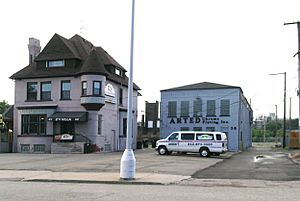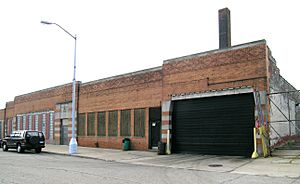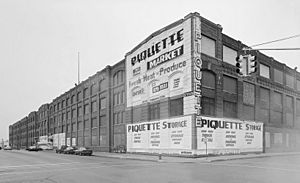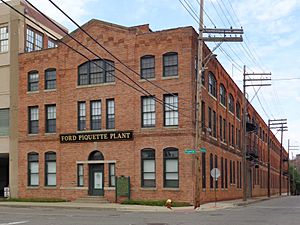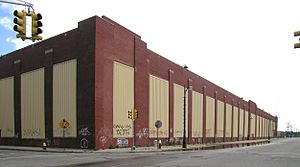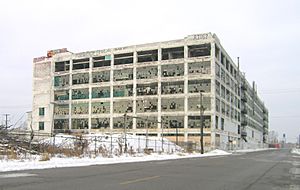Piquette Avenue Industrial Historic District facts for kids
Quick facts for kids |
|
|
Piquette Avenue Industrial Historic District
|
|
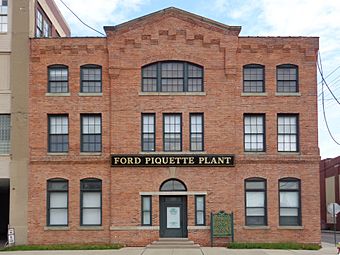
Ford Piquette Avenue Plant is a notable building in the district.
|
|
| Location | Detroit, Michigan, U.S. |
|---|---|
| Built | 1904 |
| Architect | Field, Hinchman and Smith; Smith, Hinchman and Grylls, et al. |
| Architectural style | Late Victorian, Late 19th And Early 20th Century American Movements |
| NRHP reference No. | 04000601 |
| Added to NRHP | June 15, 2004 |
The Piquette Avenue Industrial Historic District is a special area in Detroit, Michigan. It's located along Piquette Street, stretching from Woodward Avenue to Hastings Street. This historic district also reaches about one block south to Harper and one block north to the Grand Trunk Western Railroad Line. It was officially recognized as a historic place in 2004.
This area was super important for making cars in the early 1900s. Big names like Ford Motor Company, Studebaker, Cadillac, and Dodge had factories here. Even companies that made car parts, like Fisher Body, were in the district. In 1910, the two largest car makers in the world, Studebaker and Ford, were neighbors on Piquette Avenue! Today, much of the area is empty, but in the 1950s, about 50,000 people worked in the factories here.
Contents
A Look Back: History of Piquette Avenue
In the 1890s, a major railroad system called the Milwaukee Junction was built. This helped industries grow quickly in Detroit. Piquette Avenue became the heart of this industrial area. Many factories, especially car factories, were built here. The area west of Woodward Avenue is known as the New Amsterdam Historic District. The Piquette Avenue Industrial Historic District is part of the area east of Woodward.
Famous Buildings of the District
Autocar Service Building
The Autocar Service Building is found at the corner of Piquette and Brush streets. It's a cool old building that shows the history of car service in the area.
Studebaker Plant: A Story of Cars and Change
The Studebaker Plant was once a busy car factory on the north side of Piquette. It first opened in 1906 as Wayne Automotive. Later, it became part of the E-M-F Company. In 1910, Studebaker took over the plant and kept making cars there until 1925.
After Studebaker left, Chrysler used the building for car parts until the mid-1960s. The building was then used for storage and even a meat wholesaler. Sadly, in June 2005, a fire completely destroyed the plant. Plans were made in 2008 to build a shelter for homeless veterans on the site.
Ford Piquette Avenue Plant: Where the Model T Began
The Ford Piquette Avenue Plant is located at 461 Piquette. It's a three-story building designed for Ford in 1904. This is a very special place because the very first Model Ts were built right here! This building was recognized as a National Historic Landmark in 2006.
Fisher Body Plant 23
The Fisher Body Plant 23 is on the corner of Piquette and Beaubien. It was another important factory in the district.
Fisher Body Plant 21: From Cars to Warplanes
The Fisher Body Plant 21 is a large building at the corner of Piquette and St. Antoine. It was designed in 1921 by famous architect Albert Kahn. Fisher Body used it to make car bodies for Buick and Cadillac until 1925.
This plant is six stories tall and very big inside. During the Great Depression, when many people were struggling, the building was used as a soup kitchen and a shelter for people without homes. From 1930 to 1956, it was an engineering design center. During World War II, this factory helped the war effort by producing parts for airplanes like the P-80 Lockheed Shooting Star and the Vought F4U Corsair.
After 1956, the plant made Cadillac limousine bodies. General Motors (GM) closed the plant in 1984. After GM left, some paint companies used the building, but it closed for good in 1994. The City of Detroit took ownership of the building in 1999.


